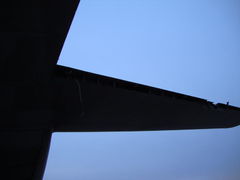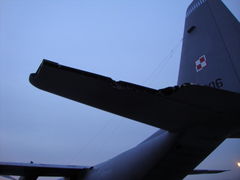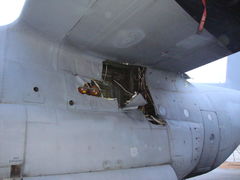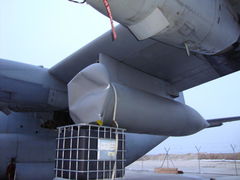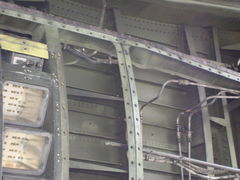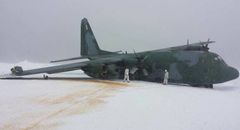-
Posts
148 -
Joined
-
Last visited
-
Days Won
6
Content Type
Profiles
Forums
Store
Gallery
Downloads
Calendar
C-130 Hercules News
Everything posted by casey
-
-
-
-
-
-
Thanks for sharing your memory with us. Judging by the fact that you mentioned him here forty-seven years later, I am assured that he was well loved. Cheers to Frank Wilson, may he rest in peace and know that he made a lasting, positive impression on those that knew him. --Casey
-
A 302nd Airlift Wing aerial firefighting C-130 Hercules aircraft returned here after seven weeks of Reserve Citizen Airmen supporting U.S. Forest Service firefighting efforts in the Western U.S., Sept. 17. The 302nd AW began Modular Airborne Fire Fighting System operations after receiving a request for assistance from the National Interagency Firefighting Center July 27. The NIFC request came due to elevated fire activity throughout California, Great Basin, the Northwest and Northern Rockies geographic areas. A 302nd Airlift Wing aerial firefighting C-130 Hercules aircraft returned here after seven weeks of Reserve Citizen Airmen supporting U.S. Forest Service firefighting efforts in the Western U.S., Sept. 17. The 302nd AW began Modular Airborne Fire Fighting System operations after receiving a request for assistance from the National Interagency Firefighting Center July 27. The NIFC request came due to elevated fire activity throughout California, Great Basin, the Northwest and Northern Rockies geographic areas. While activated, the 302nd AW operated out of Fresno Air Attack Base, California. There they joined federally-activated MAFFS-equipped C-130s from the Nevada Air National Guard’s 152nd Airlift Wing, Reno, Nevada, and the Wyoming Air National Guard’s 153rd Airlift Wing, based in Cheyenne. Earlier in July, the California Air National Guard’s 146th Airlift Wing provided MAFFS support while based out of Channel Islands Air National Guard Station, California, flying missions under a state activation with the California Department of Forestry and Fire Protection. Together, the Air Force Reserve Command’s 302nd AW and Air National Guard MAFFS wings supported fire suppression missions that took them to more than two dozen fires throughout California. “In talking to (U.S. Forest Service, Bureau of Land Management, and CalFire) lead pilots and other personnel in civil agencies, we were effective and helped contain many fires,” said Lt. Col. Luke Thompson, the 302nd AW chief of aerial firefighting. “Thanks to the crews who waited through the slow days in Fresno. We needed to be used in order to maintain proficiency. It was good we were able to be there when the activity picked back up.” The C-130 crews flew 293 sorties in 2017, dropping more than 820,000 gallons of retardant in 315 drops, all on California fires. Throughout the operation, approximately 50 aircrew, aircraft maintainers and support personnel from all four MAFFS wing’s supported the MAFFS Air Expeditionary Group mission in Fresno as well as at the NIFC headquarters in Boise, Idaho. “With aircraft already at a premium to fulfill the wing’s commitments, maintenance once again juggled their schedule to make aircraft available for firefighting," said Thompson. The 302nd AW also supported MAFFS efforts in other ways throughout 2017. Aircrew members provided MAFFS instruction to Nevada ANG personnel who this year, were going into their second year of MAFFS missions. The 302nd AW also provided command and administrative support to the MAFFS Air Expeditionary Group in Boise. “Thanks to everyone who participated while deployed, and for supporting the mission from back home by dropping their normal duties and quickly responding to the MAFFS activation,” said Thompson. The MAFFS-equipped C-130s are operated by four military airlift wings: 146th Airlift Wing, California Air National Guard; the 152nd Airlift Wing, Nevada Air National Guard, 153rd Airlift Wing, Wyoming Air National Guard; and the 302nd Airlift Wing, Peterson Air Force Base, Colorado (Air Force Reserve Command). MAFFS is a self-contained aerial firefighting system, owned by the U.S. Forest Service, that can discharge 3,000 gallons of water or fire retardant in less than five seconds, covering an area one-quarter of a mile long by 100 feet wide. Once the load is discharged, it can be refilled in less than 12 minutes. View full article
-
The C130's four propeller engines scream as it lifts lifts off from MacDill Air Force base in Tampa. The plane is loaded with pallets of medical supplies bound for St. Croix, nine days after the largest of the U.S. Virgin Islands took a direct hit from Hurricane Maria. But the flight's true mission is getting patients in critical need of health care off the island and into hospitals in Columbia, South Carolina and Atlanta. The C130's four propeller engines scream as it lifts lifts off from MacDill Air Force base in Tampa. The plane is loaded with pallets of medical supplies bound for St. Croix, nine days after the largest of the U.S. Virgin Islands took a direct hit from Hurricane Maria. But the flight's true mission is getting patients in critical need of health care off the island and into hospitals in Columbia, South Carolina and Atlanta. So far, hundreds of patients have been brought to those hospitals along with facilities in Louisiana and Mississippi. Capt. Michael Plash is in charge of the flight crew. He spoke from the plane's flight deck on the approach to St. Croix. "It's a massive operation that's going on. We have aircraft in and out, left and right, I mean it's crazy." It's the crew's second mission to the island in three days. Maria blew down buildings, disfigured trees and left a field of debris across St. Croix. Much of the island is without power and running water. Four hours after taking off, the C130 touches down. The engines keep running as a forklift removes the pallets of supplies. The crew then quickly converts the plane's fuselage into a mobile emergency room. Stretchers stacked three high run down the spine. Bags of medical equipment hang from the walls. Machines monitor vital signs. Nine patients, some in wheelchairs, others on stretchers, board the plane and the medical staff starts caring for them. Capt. Keri Lord-Morales leads the medical crew of flight nurses, doctors and a special critical care team. "We have patients who have chronic illnesses that require dialysis and we have other things such as wounds that we are dealing with and mental health issues as well," says Lord-Morales. Earl Shervington, is one of the dialysis patients heading to the mainland. The 61-year-old, who was born and raised in St. Croix, has failing kidneys and depends on machines to clean his blood three times a day. Sitting on a stretcher inside the C130, Shervington says officials feared the hospital where he received dialysis would lose generator power. "So what the government decided is to ship us out to somewhere that we can seek better help, which I think was a very good decision and a very good idea," he says. Lord-Morales says treating patients in the air comes with challenges that caregivers don't have on the ground. There's lower oxygen levels, temperature fluctuations and vibrations that can effect pain. "Those can affect their entire well-being and can change their status at any time," she explains. The members of the medical crew are reservists and many were working at hospitals throughout Florida when they got the call to serve. Capt. Sandy Mandell is a trauma nurse at Orlando Regional Medical Center. Much like the staff in an emergency room, she says, the medial flight team doesn't typically know what types of patients they'll be treating ahead of time. "We were told we were getting one patient load on the way down and we showed up and it completely changed, so flexibility is like a huge part of our job." During the flight, a nurse on the plane coordinates with the hospitals in South Carolina. When the C130 touches down in Columbia, crews on the ground take over. A second trip to Atlanta an hour later drops off the remaining patients. After roughly 12 hours of work, the crew can rest for the night. The next day, the team returns to MacDill. There, another crew is already set to go, ready to rescue another group of patients. View full article
-
Thanks for sharing the pics. Any idea when she was christened "Skeeter Swatter"?
-
The tail flash of a specially modified Air Force Reserve C-130 Hercules aircraft, assigned to the 910th Airlift Wing based at Youngstown Air Reserve Station, Ohio, is clearly visible as it is accented by the setting sun over the Kelly Field Annex here, Sept. 19, 2017. The aircraft, the 910th’s flagship, is a backup to three C-130s temporarily based at Kelly Field to conduct mosquito control aerial spray applications over areas of eastern Texas devastated by Hurricane Harvey. Since operations began, this special mission has treated more than 2.3 million acres at the direction of Federal Emergency Management Agency (FEMA) and the Texas Department of State Health Services (DSHS) to assist in recovery efforts by helping contain the significant increase in pest insects caused by large amounts of standing, stagnant water. The 910th Airlift Wing operates the Department of Defense’s only aerial spray capability to control pest insect populations, eliminate undesired and invasive vegetation and disperse oil spills in large bodies of water. (U.S. Air Force photo/Master Sgt. Bob Barko Jr.) C-130H 89-9106 c/n 5223 View full record
-
Seven Special Tactics Airmen from the Kentucky Air National Guard departed the Kentucky ANG base, Louisville, Sept. 20, 2017, for the Caribbean where they will open airfields for humanitarian aid deliveries and resident evacuations in the wake of Hurricane Maria, the third major hurricane to hit the region in the past month. Seven Special Tactics Airmen from the Kentucky Air National Guard departed the Kentucky ANG base, Louisville, Sept. 20, 2017, for the Caribbean where they will open airfields for humanitarian aid deliveries and resident evacuations in the wake of Hurricane Maria, the third major hurricane to hit the region in the past month. A four-man team from the 123rd Special Tactics Squadron arrived in St. Croix, U.S. Virgin Islands, Sept. 21, while a three-man team from the same unit is scheduled to arrive in St. Thomas, U.S. Virgin Islands, the same day, said Chief Master Sgt. Aaron May, the squadron’s enlisted manager for combat control. The mission of both teams is the same: clear the airfields of debris, open runways and taxiways and establish air traffic control so military airlift can begin. The teams are prepared, if necessary, to parachute into the fields with chainsaws so they can remove fallen trees and other obstacles, allowing the C-130 Hercules that brought them to land safely and begin offloading rescue gear. The Airmen also deployed with trucks, motorcycles and inflatable motorboats to assist with rescue operations, May said. “(This) deployment marks the third time in the past month that Kentucky Air National Guardsmen have mobilized in support of hurricane rescue operations in the Caribbean,” said Col. David Mounkes, 123rd Airlift Wing commander, parent unit to the 123rd STS. “Our Airmen stand ready at all times to answer the call for help, and we are tremendously grateful to be able to provide this assistance again. Our thoughts and prayers are with the residents of these islands as they continue to weather an unprecedented hurricane season.” The Kentucky ANG deployed more than 80 Airmen to Texas for Hurricane Harvey, establishing an aeromedical evacuation hub and saving 333 residents stranded by floodwaters in the Houston area. The unit later deployed 24 Airmen for rescue operations following Hurricane Irma, helping evacuate more than 1,000 U.S. citizens from the Dutch Caribbean Island of St. Maarten. View full article
-
After flying halfway around the world, a C-130J Super Hercules arrived at Yokota Air Base, Japan from Ramstein Air Base, Germany, Sept. 20, 2017. This is the fifth C-130J delivered to Yokota since March After flying halfway around the world, a C-130J Super Hercules arrived at Yokota Air Base, Japan from Ramstein Air Base, Germany, Sept. 20, 2017. This is the fifth C-130J delivered to Yokota since March. Yokota will receive 14 C-130Js as it modernized its existing fleet. The C-130J is the latest version of the Hercules, entering the Air Force inventory in February 1999. The aircraft has a six-bladed composite propeller coupled to a Rolls-Royce AE2100D3 turbo engine and brings substantial performance improvements. View full article
-
The U.S. Air Force plans to declare its newest gunship, the AC-130J Ghostrider, ready for combat — or initial operating capability (IOC) in acquisition parlance — this month, but the aircraft won’t actually deploy to a war zone for a couple more years, a general said. “We are declaring IOC, Initial Operating Capability, this month on the AC-J,” Lt. Gen. Marshall “Brad” Webb, head of Air Force Special Operations Command, said Tuesday during a briefing with reporters at the Air Force Association’s annual conference outside Washington, D.C The U.S. Air Force plans to declare its newest gunship, the AC-130J Ghostrider, ready for combat — or initial operating capability (IOC) in acquisition parlance — this month, but the aircraft won’t actually deploy to a war zone for a couple more years, a general said. “We are declaring IOC, Initial Operating Capability, this month on the AC-J,” Lt. Gen. Marshall “Brad” Webb, head of Air Force Special Operations Command, said Tuesday during a briefing with reporters at the Air Force Association’s annual conference outside Washington, D.C. However, the general added, “That doesn’t mean anything with respect to putting it in combat — we’re still just shy of two years away from wanting to put those in combat.” The reason for the delay is because the high pace of operations in countries like Afghanistan, Iraq and Syria makes it difficult to train special operators on the new weapon system, Webb said. “We’re not waiting around,” he said. “This is a fully configured gunship … The challenge that we have, it’s my problem, is how do we fight the current fight — we have gunships deployed to Afghanistan, Iraq, Syria — and use those same people to convert into a new weapon system? “We’re not going to have the luxury of doing what most normal units do,” he added, referring to the typical transition period for returning troops. ” “So how do I navigate having some capability in the fight, transition those same guys in those same squadrons to a new weapon system, and then build them up at the same time?” Webb said. “So that draws out the timeline from IOC of airframes to train the guys who come back from combat into a new weapon system, have them have a deployed-dwell time to make sure that they’re going to have families at the end of their 20-year career, then bring them back on the battlefield in the Js.” A heavily modified C-130, the AC-130J features fully integrated digital avionics, as well as a “Precision Strike Package.” The latter includes a mission management console, robust communications suite, two electro-optical/infrared sensors, advanced fire control equipment, precision guided munitions delivery capability as well as trainable 30mm and 105mm weapons, according to the Air Force. The cannons can be mounted on both sides of the aircraft. The Air Force currently has 10 of the Ghostriders and plans to buy a total of 37 from manufacturer Lockheed Martin Corp., the general said. The service recently retired the AC-130H and, as of last fiscal year, had a total of 31 AC-130s in the fleet, including three Ghostriders, 16 Spookys and 12 Stinger IIs, according to information compiled by the Air Force Association. View full article
-
Crowds of friends and family members gathered around a hangar looked up in awe as five C-130H Hercules flew overhead. After several months, the long wait had come to an end. Their loved ones were finally home from deployment. Once the planes landed, crew members waived American flags as planes taxied into place, and loved ones rushed out to greet the newly arrived Airmen. Some were holding small children, while others had balloons or bouquets of flowers and signs with Airmen’s names. Crowds of friends and family members gathered around a hangar looked up in awe as five C-130H Hercules flew overhead. After several months, the long wait had come to an end. Their loved ones were finally home from deployment. Once the planes landed, crew members waived American flags as planes taxied into place, and loved ones rushed out to greet the newly arrived Airmen. Some were holding small children, while others had balloons or bouquets of flowers and signs with Airmen’s names. Beginning Saturday, approximately 150 Airmen from the 94th Operations Group and 94th Maintenance Squadron returned from deployments to the Middle East in support of contingency operations. “It was incredible,” said Lt. Col. Chris Gohlke, 700th Airlift Squadron commander, describing the feeling of seeing his loved ones again after returning from a four-month deployment to Qatar. “It was a very emotional day and a happy day of course.” He said it was also nice to get back to routines and creature comforts left behind so many months ago. “The anticipation of it all is exciting,” Gohlke said. “It helps you take stock in what you’re doing and the sacrifice all these Airmen are making over there, to leave home and do the mission, but it’s worth it when you come back and get back to your family and have that joyous reunion and see everybody.” Deployments are an inevitable part of military life, and with that come many challenges, including leaving loved ones behind for an extended period of time. Many of these challenges began before the deployment. As with any other long-distance trip, it was difficult at times to plan for the logistics of moving people and equipment in such a short amount of time, explained Gohlke. The same was also true for the way back. “I almost felt like getting there and getting home were two of our biggest challenges,” said Gohlke. “Once we were there though and all those obstacles were behind us, we were cruising. We did really good things out there.” The squadron provided tactical airlifts throughout the U.S. Central Command area of responsibility, moving cargo, patients and passengers throughout the theater. They provided support in four major areas: Afghanistan, Iraq and Syria, Horn of Africa and Arabian Gulf combat support, Gohlke said. “We were also tasked to support missions into Syria for airdrop operations, which was probably one of the highlights of our deployment, that we got some combat airdrops,” said Gohlke. “We also got some combat air lands into a dirt landing zone in Syria to bring the forward most line of troops and needed supplies, weapons and ammunition. That’s something I know our crews are going to hang their hat on, something they will always remember and be proud they were able to accomplish.” Although deployments can be difficult – be it the time away from family and friends or the difficult working and living conditions – they serve as an important opportunity for Dobbins Airmen to utilize skills they’ve learned in a variety of exercises and training scenarios held throughout the year to prepare them for supporting the mission. “In 2016, we were extremely busy,” said Gohlke. “We did Saber Junction, Maple Flag and Eager Lion. We did all these large scale, OCONUS exercises, which required support from different agencies on base – not just operations and maintenance. I think that helped to exercise some of those relationships and capabilities so that when it came time to deploy, those were sharp tools.” The deployers also return with a variety of skills to help them become more well-rounded Airmen, ready to support Dobbins’ mission and requirements as well. “We gained a lot of experience from our deployment. We can bring that home and then keep that and build upon it here as well and spread it to those who didn’t get to go this time and those who come into our doors brand new, off the street and help make them better prepared for the next one.” View full article
-
WC-130J Hurricane Hunter View full record
-
The U.S. Air Force Reserves has been called in to fight a growing enemy attacking the Texas Gulf Coast in the aftermath of Hurricane Harvey: mosquitoes. The 910th Airlift Wing began flying two specially equipped C-130H cargo planes over the upper Texas Coast, while Coastal Bend communities are spraying neighborhoods by truck. The U.S. Air Force Reserves has been called in to fight a growing enemy attacking the Texas Gulf Coast in the aftermath of Hurricane Harvey: mosquitoes. The 910th Airlift Wing began flying two specially equipped C-130H cargo planes over the upper Texas Coast, while Coastal Bend communities are spraying neighborhoods by truck. Vast swarms of mosquitoes plague crews working to restore power and residents struggling to clean debris from their yards and homes. Workers in Port Aransas, Aransas Pass and Refugio have been especially infested. Adult mosquitos blown away by high hurricane winds leave behind eggs that thrive in the subsequent flooding. Any surviving adults lay even more eggs, causing a population explosion, reports the Centers for Disease Control. The first onslaught of mosquitoes following a heavy rain event like Harvey are mostly salt marsh mosquitoes, which pose no threat of diseases such as dengue or Zika virus. That will change within a few weeks, according to experts. Aedes Aegypti mosquitos, which carry the deadly Zika virus, will soon be part of the inevitable population increase in the following weeks as the pests thrive on stagnating water in ditches, bayous and flooded fields. While the Texas Department of State Health Services begin aerial spraying with the pesticide Duet all along the affected areas, trucks from municipalities will spray larvacide, which kills larvae on contact. Residents along the Coastal Bend are asked to look for and eliminate any standing water on their properties that they can. Landowners with large pools of standing water should also spray, city officials urged. Corpus Christi sprays each evening when mosquitoes are most active and bees begin to settle in for the night and are less likely to be affected. Spraying is from 7:30 p.m. to midnight by neighborhoods, which are marked on the map on this page. View full article
-
Kentucky Air Guard deploys two aircraft and 14 more Airmen for Hurricane Harvey relief operations Two C-130 Hercules aircraft and 14 more Airmen deployed from the Kentucky Air National Guard Base here tonight to fly humanitarian aid and airlift evacuation missions in Texas following unprecedented flooding caused by Hurricane Harvey. The Kentucky Air Guardsmen will operate out of Carswell Field, which is located on Naval Air Station Fort Worth Joint Reserve Base, said Capt. Nick Dobson, mission planner for the Kentucky Air Guard’s 165th Airlift Squadron. From Carswell, the Airmen expect to fly missions into Beaumont Municipal Airport, in Beaumont, Texas — the site of some of the worst flooding — to pick up dislocated residents and transport them to Dallas Love Field, Dobson said. Residents will then be moved to safe shelter by emergency responders on the ground. Chief Master Sgt. Jeff Brown, a loadmaster in the 165th Airlift Squadron, has supported hurricane relief operations in the past, including Katrina in 2005. “This is the kind of thing we train to do,” Brown said. “We train for combat and we train for humanitarian missions like this. We’ve done it before, and we’re glad to be called upon again.” Brown noted that evacuation missions require extra sensitivity on the part of Airmen because they never know what to expect. “You don’t always know if the passengers are sick or injured, you don’t know what their mental state is, so that means we have to exercise a little more care with them.” Tonight’s deployment is the third this week for members of the Kentucky Air Guard. The unit sent 18 members of its 123rd Special Tactics Squadron to the Houston area on Sunday, where they have been conducting water patrol missions with inflatable motorboats. To date, those Airmen have rescued more than 330 residents stranded by high water, and controlled air traffic for multiple helicopter landing zones. With the need for roof-top rescues now largely abated, those Airmen are expected to return to Louisville early Saturday. On Wednesday, the Kentucky Air Guard’s 123rd Contingency Response deployed 43 Airmen, augmented by six troops from the Mississippi Air Guard, to establish an air hub in Houston for air cargo and aeromedical evacuation operations. “We have a lot of unique capabilities in our wing which allow us to respond effectively during events like this, including pararescuemen, combat controllers and a Contingency Response Group — a unit whose sole reason for existence is to rapidly establish airlift hubs in areas affected by natural disasters or other contingencies,” said Col. David Mounkes, commander of the 123rd Airlift Wing, the parent unit of the 165th Airlift Squadron, the 123rd Special Tactics Flight and the 123rd Contingency Response Group. “Nothing is more rewarding than being able to put all those capabilities to use in our own homeland, helping people in need.” Source: https://www.dvidshub.net/news/247001/kentucky-air-guard-deploys-two-aircraft-and-14-more-airmenfor-hurricane-harvey-relief-operations Story bu Lt Col Dale Greer, 123 Airlift Wing Public Affairs
-
An aircrew from the 180th Airlift Squadron returned home Sept. 1, 2017 from providing airlift support in Texas in response to relief efforts from Hurricane Harvey. Part of their mission included transporting six pallets of Federal Emergency Management Agency (FEMA) supplies including blankets and Meals, Ready to Eat (MREs). They transported some 36,000 lbs of cargo, according to Maj. Nick Kahler, who was the navigator for this particular crew. An aircrew from the 180th Airlift Squadron returned home Sept. 1, 2017 from providing airlift support in Texas in response to relief efforts from Hurricane Harvey. Part of their mission included transporting six pallets of Federal Emergency Management Agency (FEMA) supplies including blankets and Meals, Ready to Eat (MREs). They transported some 36,000 lbs of cargo, according to Maj. Nick Kahler, who was the navigator for this particular crew. They also transported 66 Soldiers in the Army National Guard from Laredo to College Station, Texas. The Soldiers were further deployed to affected areas. Kahler, along with a second aircrew, arrived in Texas on Tuesday. He said they all volunteered for the mission. “It’s very busy down there,” said Kahler. “But it’s awesome to be part of this. Everyone we met was appreciative.” As both aircrews returned home to Rosecrans, two other aircrews were activated the same day and headed to Naval Air Station Fort Worth Joint Reserve Base, Texas. Those crews will remain in Texas through the Labor Day weekend providing airlift support across the state. The Missouri Air National Guard’s 139th Airlift Wing is comprised of approximately 1,200 citizen-Airmen from local communities throughout the region. The unit operates the C-130H Hercules cargo aircraft and has a dual mission to the state of Missouri and the federal government. Rosecrans Air National Guard Base is located at Rosecrans Memorial Airport, St. Joseph, Mo. View full article
-
U.S. and Romanian military members concluded a two-week bilateral training exercise on Otopeni Air Base, Romania, Aug. 31, 2017. Carpathian Fall 2017 involved participation from more than 100 Airmen from Ramstein AB, Germany, along with paratroopers from the U.S. Army and Romanian military. The exercise also saw participation from Romanian Air Force pilots who served as observers. The goal of Carpathian Fall 2017 was to enhance mission readiness and interoperability between the U.S. and Romanian military. An example of the partnership displayed during the exercise was the airlift of Romanian paratroopers on U.S. Air Force C-130J Super Hercules aircraft. Romanian Air Force aircraft also airdropped cargo delivery systems which were built by U.S. Air Force aerial delivery Airmen. U.S. and Romanian military members concluded a two-week bilateral training exercise on Otopeni Air Base, Romania, Aug. 31, 2017. Carpathian Fall 2017 involved participation from more than 100 Airmen from Ramstein AB, Germany, along with paratroopers from the U.S. Army and Romanian military. The exercise also saw participation from Romanian Air Force pilots who served as observers. The goal of Carpathian Fall 2017 was to enhance mission readiness and interoperability between the U.S. and Romanian military. An example of the partnership displayed during the exercise was the airlift of Romanian paratroopers on U.S. Air Force C-130J Super Hercules aircraft. Romanian Air Force aircraft also airdropped cargo delivery systems which were built by U.S. Air Force aerial delivery Airmen. "Every exercise provides its own challenges," said Capt. Jacob Morton, the 37th Airlift Squadron mission planning cell chief. "Some challenges can be anticipated, but sometimes the things you least expect can be the things which challenge you the most. The benefit of those challenges is that we find these things out now, rather than during combat." Morton served as the mission commander for Carpathian Fall 2017. He emphasized the importance of bilateral training, saying no country should take on a mission alone. “Ever since the dawn of warfare, alliances have been crucial to victory,” Morton said. “This principle still applies today. We succeed in missions not only through the courage of our own warfighters, but also through our bonds with our allies. We fly, fight, and win together.” Participants from Ramstein AB came from a wide range of career fields, including aircrew, weather, logistics, operations support, weather and intelligence. Besides conducting airdrops, pilots also practiced various in-flight maneuvers in the skies above Romania. C-130J Super Hercules pilots from the 37th AS conducted evasive flight maneuvers, tactical low-level flying, flare dispenses and assault landings. These flights were conducted with Romanian Air Force pilots observing in the cockpit. Maj. Corey Preston, a 37th AS C-130J instructor pilot, said he was happy with how the exercise went, and expressed his pride in the participants. “Carpathian Fall 2017 was an amazing success due to hard work and dedication of all Airmen involved,” Preston said. “We had amazing support from numerous agencies from the 86th Airlift Wing, and every Airman that was deployed in support of Carpathian Fall played an integral part in the success of the deployment, so first and foremost I'd like to congratulate and thank the team.” Preston also expressed his gratitude for the Romanian troops who hosted Airmen from Ramstein AB, adding that Romanians contributed greatly to Carpathian Fall 2017. “We also had outstanding support from our Romanian counterparts, and fostered key relationships that are essential to building partnership capacity and interoperability between our two air forces,” he added. “(They) were wonderful hosts, and we will truly miss the people and the country when we leave. All of us will have stories to tell our folks when we get back home. We hope to come back again soon and continue building our alliance with the people of Romania.” View full article
-
Two C-130 Hercules aircraft and 14 more airmen deployed from the Kentucky Air National Guard base here last night to fly humanitarian aid and airlift evacuation missions in Texas following unprecedented flooding caused by Hurricane Harvey. The Kentucky Air Guardsmen will operate out of Carswell Field, located on Naval Air Station Joint Reserve Base Fort Worth, said Air Force Capt. Nick Dobson, mission planner for the Kentucky Air Guard's 165th Airlift Squadron. From Carswell, the airmen expect to fly missions into Beaumont Municipal Airport in Beaumont, Texas -- the site of some of the worst flooding -- to pick up dislocated residents and transport them to Dallas Love Field, Dobson said. Residents will then be moved to safe shelter by emergency responders on the ground. Two C-130 Hercules aircraft and 14 more airmen deployed from the Kentucky Air National Guard base here last night to fly humanitarian aid and airlift evacuation missions in Texas following unprecedented flooding caused by Hurricane Harvey. Two C-130 Hercules aircraft and 14 airmen from the 123rd Airlift Wing deploy from the Kentucky Air National Guard base in Louisville, Ky., Sept. 1, 2017, for Texas, where they will fly humanitarian aid and airlift evacuation missions in the aftermath of Hurricane Harvey. The airmen are expected to airlift displaced residents from Beaumont, Texas, to Dallas, where they will be provided with safe shelter. Air National Guard photo by Lt. Col. Dale Greer Kentucky Air Guard deploys aircraft, Airmen for evacuation missions in Texas following Hurricane Harvey Two C-130 Hercules aircraft and 14 airmen from the 123rd Airlift Wing deploy from the Kentucky Air National Guard base in Louisville, Ky., Sept. 1, 2017, for Texas, where they will fly humanitarian aid and airlift evacuation missions in the aftermath of Hurricane Harvey. The airmen are expected to airlift displaced residents from Beaumont, Texas, to Dallas, where they will be provided with safe shelter. Air National Guard photo by Lt. Col. Dale Greer Download Image Image details page #cboxClose { position: absolute; top: 5px; right: 5px; display: block; background: url(/desktopmodules/articlecs/images/media_popup_close.png) no-repeat top center; width: 40px; height: 40px; text-indent: -9999px; } #cboxClose:hover { background-position: bottom center; } .me-plugin { width: 100%; height: 100%; } The Kentucky Air Guardsmen will operate out of Carswell Field, located on Naval Air Station Joint Reserve Base Fort Worth, said Air Force Capt. Nick Dobson, mission planner for the Kentucky Air Guard's 165th Airlift Squadron. From Carswell, the airmen expect to fly missions into Beaumont Municipal Airport in Beaumont, Texas -- the site of some of the worst flooding -- to pick up dislocated residents and transport them to Dallas Love Field, Dobson said. Residents will then be moved to safe shelter by emergency responders on the ground. Air Force Chief Master Sgt. Jeff Brown, a loadmaster in the 165th Airlift Squadron, has supported hurricane relief operations in the past, including Katrina in 2005. "This is the kind of thing we train to do," Brown said. "We train for combat and we train for humanitarian missions like this. We've done it before, and we're glad to be called upon again." Extra Sensitivity Brown noted that evacuation missions require extra sensitivity on the part of airmen because they never know what to expect. "You don't always know if the passengers are sick or injured, you don't know what their mental state is, so that means we have to exercise a little more care with them." Aerial porters from the 123rd Airlift Wing load a pallet of cargo nets onto a C-130 Hercules aircraft at the Kentucky Air National Guard base in Louisville, Ky., Sept. 1, 2017. The aircraft is one of two that will carry 14 Kentucky Air Guardsmen to Texas, where they will fly humanitarian aid and airlift evacuation missions in the aftermath of Hurricane Harvey. Air National Guard photo by Lt. Col. Dale Greer Kentucky Air Guard deploys aircraft, airmen for evacuation missions in Texas following Hurricane Harvey Aerial porters from the 123rd Airlift Wing load a pallet of cargo nets onto a C-130 Hercules aircraft at the Kentucky Air National Guard base in Louisville, Ky., Sept. 1, 2017. The aircraft is one of two that will carry 14 Kentucky Air Guardsmen to Texas, where they will fly humanitarian aid and airlift evacuation missions in the aftermath of Hurricane Harvey. Air National Guard photo by Lt. Col. Dale Greer Download Image Image details page The deployment is the third this week for members of the Kentucky Air Guard. The unit sent 18 members of its 123rd Special Tactics Squadron to the Houston area Aug. 27, where they have been conducting water patrol missions with inflatable motorboats. To date, those airmen have rescued more than 330 residents stranded by high water, and controlled air traffic for multiple helicopter landing zones. With the need for rooftop rescues now largely abated, those airmen are expected to return to Louisville early today. On Aug. 30, the Kentucky Air Guard's 123rd Contingency Response deployed 43 airmen, augmented by six troops from the Mississippi Air Guard, to establish an air hub in Houston for air cargo and aeromedical evacuation operations. "We have a lot of unique capabilities in our wing which allow us to respond effectively during events like this, including pararescuemen, combat controllers and a contingency response group -- a unit whose sole reason for existence is to rapidly establish airlift hubs in areas affected by natural disasters or other contingencies," said Air Force Col. David Mounkes, commander of the 123rd Airlift Wing, the parent unit of the 165th Airlift Squadron, the 123rd Special Tactics Flight and the 123rd Contingency Response Group. "Nothing is more rewarding than being able to put all those capabilities to use in our own homeland, helping people in need." View full article
-
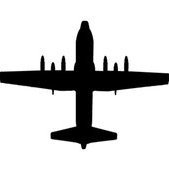
How cool is that?
casey replied to Robert Podboy's topic in C-130 Community Announcements & Promotions
Awesome!! Thanks to whomever added the link!! --Casey -
Tanker grounded while Corps probes Tuesday aviation mishap The Marine Corps on Friday announced the indefinite grounding of the tanker aircraft that mysteriously lost cabin pressure four days earlier, triggering an emergency landing and hospital care for five troops. “We want to identify exactly what caused this mishap, to learn the lessons from it and ensure that we prevent future problems,” said Marine spokeswoman Capt. Morgan M. Frazer. The pressure dip occurred around 11:20 a.m. Tuesday while the Lockheed Martin C-130J Super Hercules tanker was at 21,000 feet after taking off from Marine Corps Air Station Miramar. It was flying toward Fort Carson, Colorado, to drop off 46 members of Camp Pendleton’s 3rd Low Altitude Air Defense Battalion for training, Frazer said. The aviation crew of six “Raiders” from Miramar-based Marine Aerial Refueler Transport Squadron 352 immediately took the four-engine turboprop plane to 10,000 feet before returning to Miramar to make an emergency landing. “The crew acted properly to safely deliver the passengers to the ground,” said Frazer. The next day, four Marines and a sailor passenger began showing symptoms of decompression sickness and were treated and released by physicians at Naval Medical Center San Diego. Tuesday’s mishap came only four days after Marine Commandant Gen. Robert B. Neller ordered all squadrons to pause flights for 24-hour safety training. His call for crews to rehash the “fundamentals of safe flight operations” came in the wake of a slew of Marine aircraft accidents worldwide. The Raiders’ stand down is slated for Monday at Miramar. Three Marines died on Aug. 5 when an MV-22B Osprey assigned to the “Dragons” of the Japan-based Marine Medium Tiltrotor Squadron 265 crashed in Australia’s Shoalwater Bay during a routine training exercise. On July 10, a Hercules KC-130T aircraft crewed by the “Yankees” of the New York-based Marine Aerial Refueler Transport Squadron 45 crashed into a bean field in rural Mississippi. Fifteen Marines and a sailor died. The next day at Marine Corps Air Station New River in North Carolina, lightning struck three mechanics, killing one, while they worked on an MV-22B Osprey. They were assigned to the “Raging Bulls” of Marine Medium Tiltrotor Squadron 261. Source: http://www.sandiegouniontribune.com/military/sd-me-tanker-mishap-20170818-story.html
-
Five passengers from Marine C-130J flight display decompression sickness symptoms Five passengers from a recent Marine Corps C-130J flight displayed symptoms of decompression sickness after the aircraft experienced a loss of pressurization at 21,000 feet, according to the service. At approximately 11:20 a.m. On Aug. 15 a C-130J from Marine Aerial Refueler Transport Squadron-352 departed Marine Corps Air Station Miramar, CA, with 46 passengers and experienced pressurization loss during a scheduled training mission, according to the statement. "The air crew expertly executed appropriate procedures and safely landed at MCAS Miramar," according to the service. "Four Marines and one Sailor from 3rd Low Altitude Air Defense Battalion based at Camp Pendleton, California, displayed systems of decompression sickness the following day and were treated at Naval Medical Center San Diego. The Marines and Sailor were treated and released, and did not require hospitalization." The cause of the incident is under investigation. Source: https://insidedefense.com/insider/five-passengers-marine-c-130j-flight-display-decompression-sickness-symptoms
-
MARINE CORPS AIR STATION MIRAMAR, Calif. – At approximately 11:20 A.M., on Aug. 15, a C-130J from Marine Aerial Refueler Transport Squadron (VMGR- 352) departed Marine Corps Air Station Miramar with 46 passengers and experienced a loss of pressurization at 21,000 feet during a scheduled training mission. The air crew expertly executed appropriate procedures and safely landed at MCAS Miramar. MARINE CORPS AIR STATION MIRAMAR, Calif. – At approximately 11:20 A.M., on Aug. 15, a C-130J from Marine Aerial Refueler Transport Squadron (VMGR- 352) departed Marine Corps Air Station Miramar with 46 passengers and experienced a loss of pressurization at 21,000 feet during a scheduled training mission. The air crew expertly executed appropriate procedures and safely landed at MCAS Miramar. Four Marines and one Sailor from 3rd Low Altitude Air Defense Battalion based at Camp Pendleton, California, displayed symptoms of decompression sickness the following day and were treated at Naval Medical Center San Diego. The Marines and Sailor were treated and released, and did not require hospitalization. The cause of this incident is currently under investigation. For additional information, please call the Public Affairs Office at 858-577-6000 or email us at [email protected] View full article


